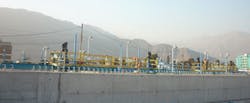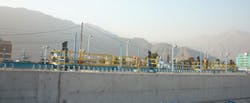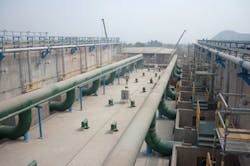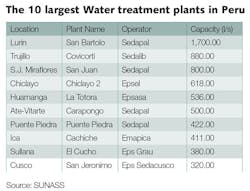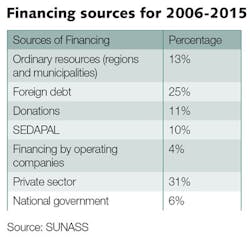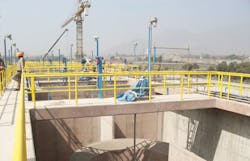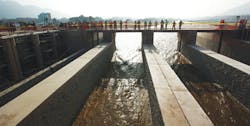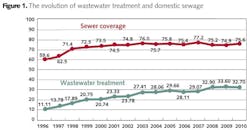Peruvian Progress for Widespread Water Coverage
Peru is facing a major challenge to bring water infrastructure online and create widespread coverage by 2015. Mauro Nogarin provides an update of the country's activities, including the Huachipa water treatment plant which will eventually help provide 2.4 million inhabitants with potable water.
In its latest report the National Superintendence of Sanitation Services (Sunass) reported that 63% of Peruvians living in urban areas have sanitation services available to them. This is provided either directly by the municipal government or a service contractor. The total output of the sewage system in 2007 was approximately 747.3 million cubic meters of wastewater.
Of that total, 217 million cubic meters per year (29.1%) was processed by a water treatment plants, many of which have operational and maintenance deficiencies. Remaining wastewater was disposed of unprocessed into the sea, rivers or lakes or was absorbed by the ground. In other words, 530 million cubic meters of wastewater eventually contaminated water sources, which in turn were used for agriculture, fishing, recreation and even drinking water. In addition, this situation limits the export of agricultural products and increases the cost of water treatment for supplying urban areas with safe drinking water.
The current inventory of wastewater treatment plants listed by SUNASS only comprises 143 sewage treatment plants, of which 92% are stabilization ponds in their different stages (anaerobic, sedimentation or aeration). A total of 112 sewage treatment plants or 78%, only use stabilization ponds.
Only five sewage treatment plants incorporate trickling filters, while three have activated sludge and one has an anaerobic reactor for excess flow.
At the same time the National Institute of Statistics (INEA) published a report stating that the population of the Lima metropolitan area has increased to 8.4 million persons, representing 28% of the total population of Peru. A recent study from Nippon Koei shows that the increase in population is creating a water shortage in the metropolitan area, where the demand is currently 24.15 million cubic meters per day (MMCD) and the availability is 19.55 MMCD, leaving a deficit of 4.60 MMCD.
These statistics make it clear that there is a great need for investment to achieve the goals set out for 2015 of having complete wastewater treatment for residential wastewater. Estimates suggest this could total an approximate investment of USD978 million. The national sanitation plan 2006-2015 calls for investments during 2009-2015 in potable water distribution and sewage, but has no concrete resources.
Water treatment levels nationally were 32.7% at the end of 2010 and projected to be 33% by 2011. This minute level of growth is due to the fact it doesn't include recent sewage collection system installations.
As far as the size of the largest sewage treatment plant in Peru, a facility in San Bartolo that is operated by Peruvian state water utility Sedapal, has a maximum flow rate of 1.7 m3/sec. The facility comprises several aeration lagoons, some partial and some complete mixture, followed by secondary lagoons for maturation and finally disinfection.
Furthermore, there are only two private initiatives for financing wastewater treatment plants: La Taboada (14 m3/sec) and La Chira (8 m3/sec). The main source of financing remains public debt (25%). This financing is linked to the operator paying back part of the debt, in other words the service operator guaranteed by the Peruvian government.
Drinking water
Similarly, Sedapal has had to significantly increase its efforts on potable water. Between August 2006 and December 2010 it completed 78 expansion projects adding 199,181 new water connections and 175,792 sewage connections. These projects bring service to approximately 1,056,880 low income persons located in the suburbs of the city.
Without question, the most important expansion project to date has been the construction of the Huachipa water treatment plant, which together with the Ramal Norte plant provide 2.4 million inhabitants with potable water. The cost of this project was USD 318 million and provides service to the inhabitants of the following neighborhoods: Lurigancho-Chosica, San Juan de Lurigancho, Comas, Carabayllo, Los Olivos, Puente Piedra, San Martín de Porres and El Callao, all located in the Lima Metropolitan area.
The contract, signed by the Ministry of Housing, Construction and Sanitation, and Sedapal consortium made up of Carmargo Corrêa and Veolia Water Brasil, totals US$270 million and includes the operation of the system for a period of four years. Veolia's division office for Design & Building (D&B) is located in Brazil, and the Huachipa contract allows Veolia Water Brasil the expansion of its operations in Latin America, a strategic market for the company.
This plant is only part of an overall integrated project to use water resources from the Andes Mountains and bring them to the city through the Rimac River and the Huascacocha Dam, which is under currently construction.
The distribution to one million new consumers is paid for under the Water for All Program (Programa Agua para Todos). The sewage waters will be processed by the Taboada Sewage Treatment plant currently under construction and the existing plant at La Chiapa. Construction of the projects generated 1,500 direct jobs and 4,500 indirect jobs.
In its first stage, the Huachipa water treatment plant has a capacity of producing five cubic meters per second and includes two raw water reservoirs and a 77,300 cubic meter reservoir for treated waters. The five storage reservoirs built out of concrete are the following: Jicamarca (2,000 m3), Canto Grande (9,000 m3) and three additional reservoirs of 4,000 m³ each located in Collique, Comas Bajo and San Martín de Porres.
Also, 10 cubic meters per second intake valves on the right bank of the Rimac River have been built, which required 11,911 cubic meters of concrete and 1,597 tons of steel. The project also includes a pipeline of 27.2 kilometers, called Ramal norte, which included 10 kilometers of tunnels in two stages (tunnel 1 and 2).
Technology
The treatment system of Huachipa is a landmark project because it marks the entrance of the company in that country. It successfully combines Veolia's technologies such as Multiflo and TGV Filters, which allowed the building of the plant in a reduced area, and which, based on the usage of the drying bed, allowed the operation of the treatment system despite water flow and variations in the water to be treated.
The Multiflo technology was used together with Turbomix. The use of Multiflo allows the formation of a thicker sludge in the bottom of the lamellar decanter and optimizes the following phases of sludge thickening and dehydration.
Turbomix, on the other hand, increases the mix gradient, thus resulting in higher efficiency of the contact between the chemicals and the liquid mass to be treated in the phases of coagulation and flocculation.
The TGV Filter, with its optimized project, allows for a quick gravitational water filtering using a smaller area. At the Huachipa water treatment plant, the filtering bed is made of only one layer of sand.
Depending on the quality of water to be treated and on the characteristics of the project, different filters may will be used in the Huachipa plant to dehydrate the sludge, taking in to consideration the local characteristics and especially the wide range of solids present in raw water throughout the year.
Additional work associated with the construction of the Ramal Norte are 60% completed at a cost of USD6 million. They include the installation of 33 kilometers of pipe to connect the Ramal Norte reservoirs to existing reservoirs, the installation of 13 kilometers of overflow pipe for future expansion as well as the maintenance of 36 existing reservoirs and six cisterns.
Other projects under construction
As of December 2011, two water treatment projects were under construction. Two waste water treatment plants: La Taboada and La Chira.
The wastewater treatment plant at La Chira required a total investment of USD87.58 million by the consortium made up of Acciona Agua (Spain) and Graña y Montero S.A. (Peru), the latter is also in charge of the construction of the project. As of December 2011 the La Chira water treatment plant was 49% completed.
When fully operational, the La Chira wastewater treatment plant will have an average flow rate of 6.3 cubic meters per second and a maximum flow of 11.3 cubic meters per second during peak operational hours. Wastewater to be treated at La Chira comes from the 2.5 million inhabitants located to the west of Lima. The water treatment plant of La Taboada has an average flow rate of 14 cubic meters per second and a maximum flow rate of 20.3 cubic meters per second during peak hours and provides water treatment for sewage from 27 metropolitan districts in Lima. The total cost of the project will be USD173.74 million.
With only three years left to create widespread residential coverage and reduce the amount of disposed untreated wastewater, these facilities couldn't come online soon enough.
More Water & WasteWater International Current Issue Articles
More Water & WasteWater International Archives Issue Articles
